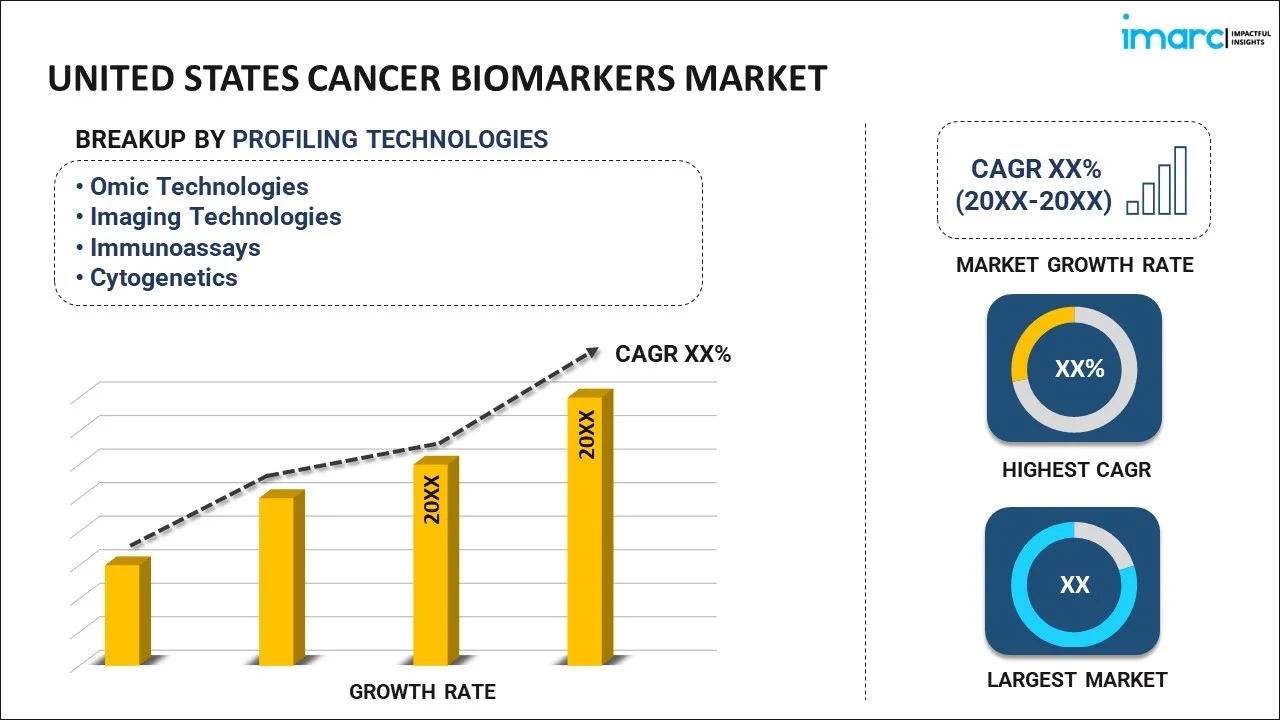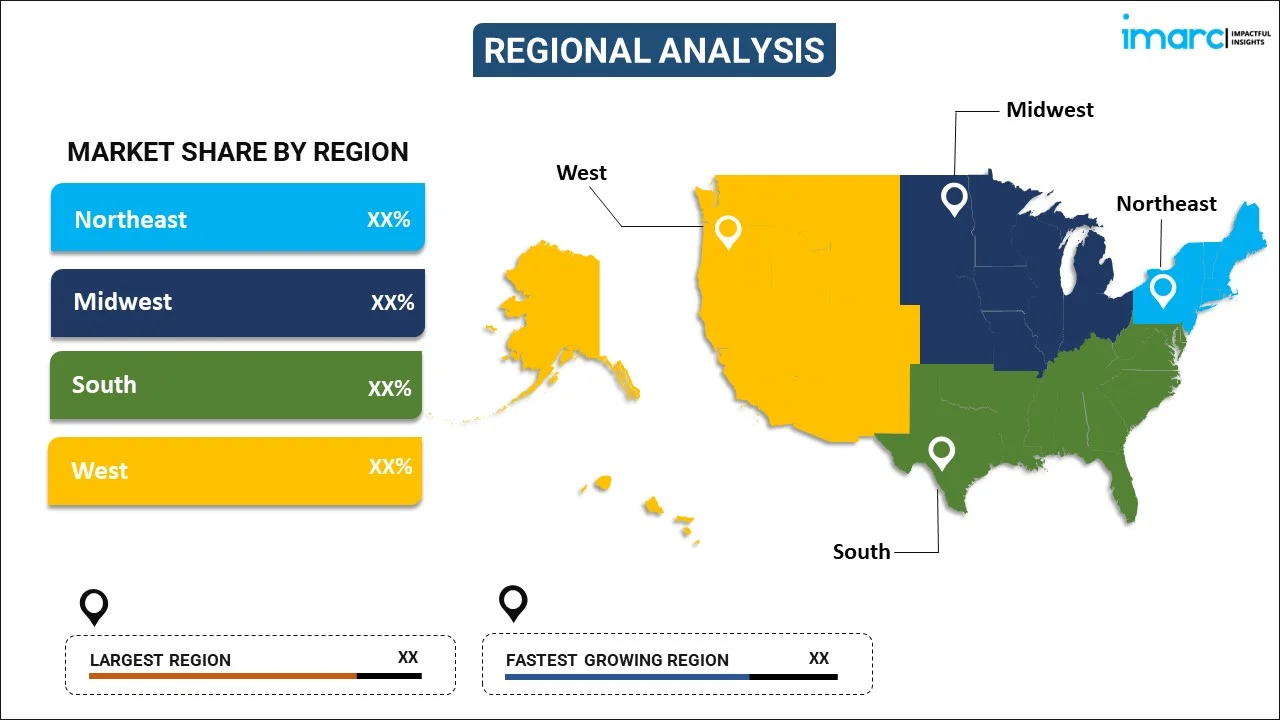
United States Cancer Biomarkers Market Report by Profiling Technology (Omic Technologies, Imaging Technologies, Immunoassays, Cytogenetics), Biomolecule (Genetic Biomarkers, Protein Biomarkers, Glyco-Biomarkers), Cancer Type (Breast Cancer, Lung Cancer, Colorectal Cancer, Prostate Cancer, Stomach Cancer, and Others), Application (Diagnostics, Prognostics, Risk Assessment, Drug Discovery and Development, and Others), End User (Hospitals, Academic and Research Institutions, Ambulatory Surgical Centers, Diagnostic Laboratories, and Others), and Region 2025-2033
Market Overview:
United States cancer biomarkers market size reached USD 7.7 Billion in 2024. Looking forward, IMARC Group expects the market to reach USD 22.0 Billion by 2033, exhibiting a growth rate (CAGR) of 11.02% during 2025-2033. The emerging shift towards precision medicine and personalized therapies, which has increased the demand for specific biomarkers that can help identify the most effective treatment options for individual patients, is driving the market.
|
Report Attribute
|
Key Statistics
|
|---|---|
|
Base Year
|
2024 |
|
Forecast Years
|
2025-2033
|
|
Historical Years
|
2019-2024
|
| Market Size in 2024 | USD 7.7 Billion |
| Market Forecast in 2033 | USD 22.0 Billion |
| Market Growth Rate (2025-2033) | 11.02% |
Cancer biomarkers are molecules or genetic alterations that can be objectively measured and indicate the presence of cancer or its potential for development. These markers play a crucial role in cancer diagnosis, prognosis, and treatment. They can be found in various biological substances, such as blood, tissues, or urine. Biomarkers help identify specific cancer types, assess the disease's stage, and predict patient responses to certain therapies. Additionally, they aid in monitoring treatment effectiveness and detecting recurrence. Advances in molecular biology and genomics have led to the discovery of numerous cancer biomarkers, contributing to personalized medicine approaches. By providing valuable information about the molecular characteristics of tumors, cancer biomarkers enhance the understanding of the disease and guide more targeted and effective treatment strategies.
United States Cancer Biomarkers Market Trends:
The cancer biomarkers market in the United States is experiencing robust growth, driven by a myriad of factors that collectively underscore its significance in the field of oncology. Firstly, advancements in genomic and proteomic technologies have catalyzed the identification of novel biomarkers, expanding the repertoire of diagnostic and prognostic tools. Moreover, the escalating incidence of cancer in the United States has intensified the demand for precise and early detection methods, amplifying the market's momentum. Furthermore, the increasing emphasis on personalized medicine has propelled R&D efforts to unravel specific biomarkers associated with individual patient profiles. This approach not only enhances diagnostic accuracy but also facilitates targeted therapeutic interventions, fostering market expansion. In addition to this, collaborative initiatives between academic institutions, research organizations, and pharmaceutical companies have accelerated biomarker discovery, creating a symbiotic relationship that propels the market forward. Parallelly, the growing adoption of liquid biopsy techniques, coupled with non-invasive diagnostic methodologies, has contributed significantly to the market's attractiveness. These developments, underpinned by technological innovation, emphasize the pivotal role of cancer biomarkers in revolutionizing cancer diagnosis and treatment strategies. As a result, the regional market is poised for sustained growth, with these interconnected drivers steering its trajectory toward a future characterized by enhanced precision and efficacy in cancer management.
United States Cancer Biomarkers Market Segmentation:
IMARC Group provides an analysis of the key trends in each segment of the market, along with forecasts at the country level for 2025-2033. Our report has categorized the market based on profiling technology, biomolecule, cancer type, application, and end user.
Profiling Technology Insights:

- Omic Technologies
- Imaging Technologies
- Immunoassays
- Cytogenetics
The report has provided a detailed breakup and analysis of the market based on the profiling technology. This includes omic technologies, imaging technologies, immunoassays, and cytogenetics.
Biomolecule Insights:
- Genetic Biomarkers
- Protein Biomarkers
- Glyco-Biomarkers
A detailed breakup and analysis of the market based on the biomolecule have also been provided in the report. This includes genetic biomarkers, protein biomarkers, and glyco-biomarkers.
Cancer Type Insights:
- Breast Cancer
- Lung Cancer
- Colorectal Cancer
- Prostate Cancer
- Stomach Cancer
- Others
The report has provided a detailed breakup and analysis of the market based on the cancer type. This includes breast cancer, lung cancer, colorectal cancer, prostate cancer, stomach cancer, and others.
Application Insights:
- Diagnostics
- Prognostics
- Risk Assessment
- Drug Discovery and Development
- Others
A detailed breakup and analysis of the market based on the application have also been provided in the report. This includes diagnostics, prognostics, risk assessment, drug discovery and development, and others.
End User Insights:
- Hospitals
- Academic and Research Institutions
- Ambulatory Surgical Centers
- Diagnostic Laboratories
- Others
The report has provided a detailed breakup and analysis of the market based on the end user. This includes hospitals, academic and research institutions, ambulatory surgical centers, diagnostic laboratories, and others.
Regional Insights:

- Northeast
- Midwest
- South
- West
The report has also provided a comprehensive analysis of all the major regional markets, which include Northeast, Midwest, South, and West.
Competitive Landscape:
The market research report has also provided a comprehensive analysis of the competitive landscape in the market. Competitive analysis such as market structure, key player positioning, top winning strategies, competitive dashboard, and company evaluation quadrant has been covered in the report. Also, detailed profiles of all major companies have been provided.
United States Cancer Biomarkers Market Report Coverage:
| Report Features | Details |
|---|---|
| Base Year of the Analysis | 2024 |
| Historical Period | 2019-2024 |
| Forecast Period | 2025-2033 |
| Units | Billion USD |
| Scope of the Report | Exploration of Historical Trends and Market Outlook, Industry Catalysts and Challenges, Segment-Wise Historical and Future Market Assessment:
|
| Profiling Technologies Covered | Omic Technologies, Imaging Technologies, Immunoassays, Cytogenetics |
| Biomolecules Covered | Genetic Biomarkers, Protein Biomarkers, Glyco-Biomarkers |
| Cancer Types Covered | Breast Cancer, Lung Cancer, Colorectal Cancer, Prostate Cancer, Stomach Cancer, Others |
| Applications Covered | Diagnostics, Prognostics, Risk Assessment, Drug Discovery and Development, Others |
| End Users Covered | Hospitals, Academic and Research Institutions, Ambulatory Surgical Centers, Diagnostic Laboratories, Others |
| Regions Covered | Northeast, Midwest, South, West |
| Customization Scope | 10% Free Customization |
| Post-Sale Analyst Support | 10-12 Weeks |
| Delivery Format | PDF and Excel through Email (We can also provide the editable version of the report in PPT/Word format on special request) |
Key Questions Answered in This Report:
- How has the United States cancer biomarkers market performed so far and how will it perform in the coming years?
- What is the breakup of the United States cancer biomarkers market on the basis of profiling technology?
- What is the breakup of the United States cancer biomarkers market on the basis of biomolecule?
- What is the breakup of the United States cancer biomarkers market on the basis of cancer type?
- What is the breakup of the United States cancer biomarkers market on the basis of application?
- What is the breakup of the United States cancer biomarkers market on the basis of end user?
- What are the various stages in the value chain of the United States cancer biomarkers market?
- What are the key driving factors and challenges in the United States cancer biomarkers?
- What is the structure of the United States cancer biomarkers market and who are the key players?
- What is the degree of competition in the United States cancer biomarkers market?
Key Benefits for Stakeholders:
- IMARC’s industry report offers a comprehensive quantitative analysis of various market segments, historical and current market trends, market forecasts, and dynamics of the United States cancer biomarkers market from 2019-2033.
- The research report provides the latest information on the market drivers, challenges, and opportunities in the United States cancer biomarkers market.
- Porter's five forces analysis assist stakeholders in assessing the impact of new entrants, competitive rivalry, supplier power, buyer power, and the threat of substitution. It helps stakeholders to analyze the level of competition within the United States cancer biomarkers industry and its attractiveness.
- Competitive landscape allows stakeholders to understand their competitive environment and provides an insight into the current positions of key players in the market.
Need more help?
- Speak to our experienced analysts for insights on the current market scenarios.
- Include additional segments and countries to customize the report as per your requirement.
- Gain an unparalleled competitive advantage in your domain by understanding how to utilize the report and positively impacting your operations and revenue.
- For further assistance, please connect with our analysts.
 Request Customization
Request Customization
 Speak to an Analyst
Speak to an Analyst
 Request Brochure
Request Brochure
 Inquire Before Buying
Inquire Before Buying




.webp)




.webp)












